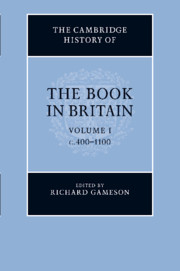Book contents
- Frontmatter
- 1 From Vindolanda to Domesday: the book in Britain from the Romans to the Normans
- PART I THE MAKING OF BOOKS
- PART II THE CIRCULATION OF BOOKS
- PART III TYPES OF BOOKS AND THEIR USES
- 15 The book in Roman Britain
- 16 The use of the book in Wales, c. 400–1100
- 17 The biblical manuscripts of Anglo-Saxon England
- 18 Anglo-Saxon gospel-books, c. 900–1066
- 19 Liturgical books
- 20 Anglo-Saxon prayerbooks
- 21 Psalters
- 22 Music books
- 23 Anglo-Saxon schoolbooks
- 24 Law books
- 25 Manuscripts of the Anglo-Saxon Chronicle
- 26 Old English homiliaries and poetic manuscripts
- PART IV COLLECTIONS OF BOOKS
- PART V CODA
- Bibliography
- Concordance of named manuscripts
- Index of manuscripts
- General Index
- Plate 4.1: The Lindisfarne Gospels"
- Plate 5.1: The Lichfield/St Chad Gospels"
26 - Old English homiliaries and poetic manuscripts
from PART III - TYPES OF BOOKS AND THEIR USES
Published online by Cambridge University Press: 28 March 2012
- Frontmatter
- 1 From Vindolanda to Domesday: the book in Britain from the Romans to the Normans
- PART I THE MAKING OF BOOKS
- PART II THE CIRCULATION OF BOOKS
- PART III TYPES OF BOOKS AND THEIR USES
- 15 The book in Roman Britain
- 16 The use of the book in Wales, c. 400–1100
- 17 The biblical manuscripts of Anglo-Saxon England
- 18 Anglo-Saxon gospel-books, c. 900–1066
- 19 Liturgical books
- 20 Anglo-Saxon prayerbooks
- 21 Psalters
- 22 Music books
- 23 Anglo-Saxon schoolbooks
- 24 Law books
- 25 Manuscripts of the Anglo-Saxon Chronicle
- 26 Old English homiliaries and poetic manuscripts
- PART IV COLLECTIONS OF BOOKS
- PART V CODA
- Bibliography
- Concordance of named manuscripts
- Index of manuscripts
- General Index
- Plate 4.1: The Lindisfarne Gospels"
- Plate 5.1: The Lichfield/St Chad Gospels"
Summary
Apart from scraps of English as marginalia in Latin manuscripts or occasional sentences in documents, the history of the book in English begins in the ninth century, most of the material from that period dating from the last decade of the century and being related to the literary activities of King Alfred and his intellectual circle. As the tenth century proceeds, increasing numbers of manuscripts survive, but it is from the eleventh that the greatest number dates. Here we find a use of the vernacular unparalleled in any other Western European language until the later Middle Ages. Well over 200 manuscripts and documents written in English by more than 500 scribes survive from this century. If one adds the large number of English and Latin manuscripts with occasional glosses and marginalia by other hands, we have an extraordinary number of people writing English – probably more than a thousand.
It is usually assumed that the most important survivals from the period are books containing poetry. There is occasional verse in a variety of manuscript contexts during the tenth and eleventh centuries, but most of the poems that we consider important occur in four large volumes. Two date from the 970s, the other two from the end of the century or the beginning of the eleventh. The earlier two, the Exeter and Vercelli Books, are named for the towns in which they now rest. The former is a large anthology of secular and religious verse given to Exeter by Leofric, bishop of Devon and Cornwall 1046–72, as part of a bequest of over fifty books (many of which can still be identified). This was some hundred years after it was written and we know nothing of where Leofric had found the book. Leofric moved his see from Crediton to Exeter in 1050 and he clearly attempted to build a substantial library in the new episcopal base.
Keywords
- Type
- Chapter
- Information
- The Cambridge History of the Book in Britain , pp. 553 - 562Publisher: Cambridge University PressPrint publication year: 2011
- 1
- Cited by



